Impact of Decentralization and Rail Network Extension on Future Traffic in the Bangkok Metropolitan Region
Abstract
:1. Introduction
2. Literature Review
3. Data
4. Methodology
4.1. SILO
4.2. Trip Distribution and Modal Share Estimation
4.3. MATSim
5. Scenarios for Transport Policy Measures
6. Results
6.1. Future Population
6.2. Travel Time and Congestion by Scenario
7. Discussion and Conclusions
Author Contributions
Funding
Institutional Review Board Statement
Informed Consent Statement
Data Availability Statement
Acknowledgments
Conflicts of Interest
References
- Dulal, H.B. Making cities resilient to climate change: Identifying “win–win” interventions. Local Environ. 2016, 22, 106–125. [Google Scholar] [CrossRef]
- United Nations. World Urbanization Prospects. The 2018 Revision; United Nations: New York, NY, USA, 2019. [Google Scholar]
- Toyota Mobility Foundation. Sathorn Model Summary Report; Chulalongkorn University: Bangkok, Thailand, 2017; Available online: https://drive.google.com/file/d/1cxOWsOAJQNZiNtjxeyp9BATVPvBN96Mj/view (accessed on 1 October 2021).
- Bhu-Anantanondh, N.; Kanyajit, S.; Suwannanon, A.; Sinloyma, P. Solving Bangkok’s Traffic Problems. Cosmop. Civ. Soc. Interdiscip. J. 2021, 13, 46–61. [Google Scholar] [CrossRef]
- Peungnumsai, A.; Miyazaki, H.; Witayangkurn, A.; Kim, S.M. A Grid-Based Spatial Analysis for Detecting Supply–Demand Gaps of Public Transports: A Case Study of the Bangkok Metropolitan Region. Sustainability 2020, 12, 382. [Google Scholar] [CrossRef]
- Office of Transport and Traffic Policy and Planning. Mass Rapid Transit Master Plan in Bangkok Metropolitan Region (M-Map); Ministry of Transport: Bangkok, Thailand, 2010.
- Kii, M. Projecting future populations of urban agglomerations around the world and through the 21st century. npj Urban Sustain. 2021, 1, 10. [Google Scholar] [CrossRef]
- Kasikorn Research Center. Impacts of Traffic Congestion on Bangkok’s Economy and Life (Current Issue No. 2771 Full Ed.). Available online: https://www.kasikornresearch.com/en/analysis/k-econ/economy/Pages/35760.aspx (accessed on 15 October 2021).
- Japan International Cooperation Agency (JICA). Data Collection Survey on The Development of Blueprint for the Second Mass Rapid Transit Master Plan (M-Map2) in The Kingdom of Thailand; Japan International Cooperation Agency; ALMEC Corp.; Oriental Consultants Global Co., Ltd.; Tokyo Metro Co., Ltd.; Creative Research and Planning Co., Ltd.: Bangkok, Thailand, 2019.
- Bangkok Metropolitan Administration. Draft Bangkok Comprehensive Plan: 4th Revision; Bangkok Metropolitan Administration: Bangkok, Thailand, 2019.
- Kanaroglou, P.S.; Higgins, C.D.; Chowdhury, T.A. Excess commuting: A critical review and comparative analysis of concepts, indices, and policy implications. J. Transp. Geogr. 2015, 44, 13–23. [Google Scholar] [CrossRef]
- Zhang, W.; Kockelman, K.M. Congestion pricing effects on firm and household location choices in monocentric and polycentric cities. Reg. Sci. Urban Econ. 2016, 58, 1–12. [Google Scholar] [CrossRef]
- Kii, M.; Nakanishi, H.; Nakamura, K.; Doi, K. Transportation and spatial development: An overview and a future direction. Transp. Policy 2016, 49, 148–158. [Google Scholar] [CrossRef]
- Ahmad, S.; de Oliveira, J.A.P. Determinants of urban mobility in India: Lessons for promoting sustainable and inclusive urban transportation in developing countries. Transp. Policy 2016, 50, 106–114. [Google Scholar] [CrossRef] [Green Version]
- Capurso, M.; Hess, S.; Dekker, T. Modelling the role of consideration of alternatives in mode choice: An application on the Rome-Milan corridor. Transp. Res. Part A Policy Pract. 2019, 129, 170–184. [Google Scholar] [CrossRef]
- Gao, Y.; Newman, P. Beijing’s Peak Car Transition: Hope for Emerging Cities in the 1.5 °C Agenda. Urban Plan. 2018, 3, 82–93. [Google Scholar] [CrossRef] [Green Version]
- Wasuntarasook, V.; Hayashi, Y. A Historic Review on Consequences of Critical Events Leading Revolution in Mass Rapid Transit in Bangkok. In Proceedings of the Eastern Asia Society for Transportation Studies, Taipei, Taiwan, 9–12 September 2013; Volume 9, pp. 9–12. [Google Scholar]
- Acheampong, R.A.; Silva, E. Land use–Transport interaction modeling: A review of the literature and future research directions. J. Transp. Land Use 2015, 8, 11–38. [Google Scholar] [CrossRef]
- Cools, M.; Fabbro, Y.; Bellemans, T. Free public transport: A socio-cognitive analysis. Transp. Res. Part A Policy Pract. 2016, 86, 96–107. [Google Scholar] [CrossRef] [Green Version]
- Fujii, S.; Kitamura, R. What does a one-month free bus ticket do to habitual drivers? An experimental analysis of habit and attitude change. Transportation 2003, 30, 81–95. [Google Scholar] [CrossRef]
- Hensher, D.A.; Stopher, P.; Bullock, P. Service quality––Developing a service quality index in the provision of commercial bus contracts. Transp. Res. Part A Policy Pract. 2003, 37, 499–517. [Google Scholar] [CrossRef]
- Kingham, S.; Dickinson, J.; Copsey, S. Travelling to work: Will people move out of their cars. Transp. Policy 2001, 8, 151–160. [Google Scholar] [CrossRef]
- Hess, D.; Yoh, A.; Iseki, H.; Taylor, B. Increasing Transit Ridership: A Survey of Successful Transit Systems in the 1990s. J. Public Transp. 2002, 5, 33–66. [Google Scholar] [CrossRef] [Green Version]
- Fiorio, C.V.; Percoco, M. Would You Stick to Using Your Car Even If Charged? Evidence from Trento, Italy. Transp. Rev. 2007, 27, 605–620. [Google Scholar] [CrossRef]
- Chen, C.; Varley, D.; Chen, J. What Affects Transit Ridership? A Dynamic Analysis involving Multiple Factors, Lags and Asymmetric Behaviour. Urban Stud. 2010, 48, 1893–1908. [Google Scholar] [CrossRef]
- Holmgren, J. Meta-analysis of public transport demand. Transp. Res. Part A Policy Pract. 2007, 41, 1021–1035. [Google Scholar] [CrossRef] [Green Version]
- Urbanek, A. Potential of modal shift from private cars to public transport: A survey on the commuters’ attitudes and willingness to switch—A case study of Silesia Province, Poland. Res. Transp. Econ. 2021, 85, 101008. [Google Scholar] [CrossRef]
- Redman, L.; Friman, M.; Gärling, T.; Hartig, T. Quality attributes of public transport that attract car users: A research review. Transp. Policy 2013, 25, 119–127. [Google Scholar] [CrossRef]
- Wegener, M. Overview of Land Use Transport Models. In Handbook of Transport Geography and Spatial Systems; Hensher, D.A., Button, K.J., Haynes, K.E., Stopher, P.R., Eds.; Emerald Group Publishing Limited: Bingley, UK, 2004; Volume 5, pp. 127–146. [Google Scholar]
- Hunt, J.D.; Kriger, D.S.; Miller, E.J. Current operational urban land-use–transport modelling frameworks: A review. Transp. Rev. 2005, 25, 329–376. [Google Scholar] [CrossRef]
- Iacono, M.; Levinson, D.; El-Geneidy, A. Models of Transportation and Land Use Change: A Guide to the Territory. J. Plan. Lit. 2008, 22, 323–340. [Google Scholar] [CrossRef]
- Fujita, M.; Ogawa, H. Multiple equilibria and structural transition of non-monocentric urban configurations. Reg. Sci. Urban Econ. 1982, 12, 161–196. [Google Scholar] [CrossRef]
- Lucas, R.E.; Rossi-Hansberg, E. On the Internal Structure of Cities. Econometrica 2002, 70, 1445–1476. [Google Scholar] [CrossRef]
- Huang, H.-J.; Xia, T.; Tian, Q.; Liu, T.-L.; Wang, C.; Li, D. Transportation issues in developing China’s urban agglomerations. Transp. Policy 2020, 85, A1–A22. [Google Scholar] [CrossRef]
- Kloosterman, R.C.; Lambregts, B. Clustering of Economic Activities in Polycentric Urban Regions: The Case of the Randstad. Urban Stud. 2001, 38, 717–732. [Google Scholar] [CrossRef]
- Xu, S.-X.; Liu, T.-L.; Huang, H.-J.; Wang, D.Z.W. Optimizing the number of employment subcenters to decentralize a congested city. Reg. Sci. Urban Econ. 2021, 90, 103699. [Google Scholar] [CrossRef]
- Giuliano, G.; Small, K.A. Is the Journey to Work Explained by Urban Structure? Urban Stud. 2016, 30, 1485–1500. [Google Scholar] [CrossRef] [Green Version]
- Gordon, P.; Richardson, H.W. Are Compact Cities a Desirable Planning Goal? J. Am. Plan. Assoc. 1997, 63, 95–106. [Google Scholar] [CrossRef]
- Gordon, P.; Wong, H.L. The Costs of Urban Sprawl: Some New Evidence. Environ. Plan. A Econ. Space 1985, 17, 661–666. [Google Scholar] [CrossRef]
- Levinson, D.M.; Kumar, A. The Rational Locator: Why Travel Times Have Remained Stable. J. Am. Plan. Assoc. 1994, 60, 319–332. [Google Scholar] [CrossRef]
- Ewing, R.; Tian, G.; Lyons, T. Does compact development increase or reduce traffic congestion? Cities 2018, 72, 94–101. [Google Scholar] [CrossRef] [Green Version]
- Ewing, R. Is Los Angeles-Style Sprawl Desirable? J. Am. Plan. Assoc. 1997, 63, 107–126. [Google Scholar] [CrossRef]
- Næss, P. Accessibility, Activity Participation and Location of Activities: Exploring the Links between Residential Location and Travel Behaviour. Urban Stud. 2016, 43, 627–652. [Google Scholar] [CrossRef]
- Susilo, Y.O.; Maat, K. The influence of built environment to the trends in commuting journeys in the Netherlands. Transportation 2007, 34, 589–609. [Google Scholar] [CrossRef]
- Li, Y.; Xiong, W.; Wang, X. Does polycentric and compact development alleviate urban traffic congestion? A case study of 98 Chinese cities. Cities 2019, 88, 100–111. [Google Scholar] [CrossRef]
- Kii, M.; Goda, Y.; Vichiensan, V.; Miyazaki, H.; Moeckel, R. Assessment of Spatiotemporal Peak Shift of Intra-Urban Transportation Taking a Case in Bangkok, Thailand. Sustainability 2021, 13, 6777. [Google Scholar] [CrossRef]
- Moeckel, R. Constraints in household relocation: Modeling land-use/transport interactions that respect time and monetary budgets. J. Transp. Land Use 2016, 10, 1. [Google Scholar] [CrossRef] [Green Version]
- Horni, A.; Nagel, K.; Axhausen, K.W. (Eds.) The Multi-Agent Transport Simulation MATSim; Ubiquity Press: London, UK, 2016; License: CC-BY 4.0. [Google Scholar] [CrossRef]
- Wegener, M. Operational urban models. J. Am. Plan. Assoc. 1994, 60, 17–29. [Google Scholar] [CrossRef]
- Kii, M.; Goda, Y.; Tamaki, T.; Suzuki, T. Evaluating Public Transit Reforms for Shrinking and Aging Populations: The Case of Takamatsu, Japan. Future Transp. 2021, 1, 486–504. [Google Scholar] [CrossRef]
- Llorca, C.; Moeckel, R. Effects of scaling down the population for agent-based traffic simulations. Procedia Comput. Sci. 2019, 151, 782–787. [Google Scholar] [CrossRef]
- Ibraeva, A.; Van Wee, B.; Correia, G.H.D.A.; Antunes, A.P. Longitudinal macro-analysis of car-use changes resulting from a TOD-type project: The case of Metro do Porto (Portugal). J. Transp. Geogr. 2021, 92, 103036. [Google Scholar] [CrossRef]
- Zhang, Y.; Zheng, S.; Sun, C.; Wang, R. Does subway proximity discourage automobility? Evidence from Beijing. Transp. Res. Part D Transp. Environ. 2017, 52, 506–517. [Google Scholar] [CrossRef]
- Li, X.; Mou, Y.; Wang, H.; Yin, C.; He, Q. How Does Polycentric Urban Form Affect Urban Commuting? Quantitative Measurement Using Geographical Big Data of 100 Cities in China. Sustainability 2018, 10, 4566. [Google Scholar] [CrossRef] [Green Version]
- Achariyaviriya, W.; Hayashi, Y.; Takeshita, H.; Kii, M.; Vichiensan, V.; Theeramunkong, T. Can Space–Time Shifting of Activities and Travels Mitigate Hyper-Congestion in an Emerging Megacity, Bangkok? Effects on Quality of Life and CO2 Emission. Sustainability 2021, 13, 6547. [Google Scholar] [CrossRef]
- Santos, G.; Fraser, G. Road pricing: Lessons from London. Econ. Policy 2006, 21, 264–310. [Google Scholar] [CrossRef]
- Marshall, S.; Banister, D. Travel reduction strategies: Intentions and outcomes. Transp. Res. Part A Policy Pract. 2000, 34, 321–338. [Google Scholar] [CrossRef]
- Shannon, T.; Giles-Corti, B.; Pikora, T.; Bulsara, M.; Shilton, T.; Bull, F. Active commuting in a university setting: Assessing commuting habits and potential for modal change. Transp. Policy 2006, 13, 240–253. [Google Scholar] [CrossRef]
- Banister, D. The sustainable mobility paradigm. Transp. Policy 2008, 15, 73–80. [Google Scholar] [CrossRef]
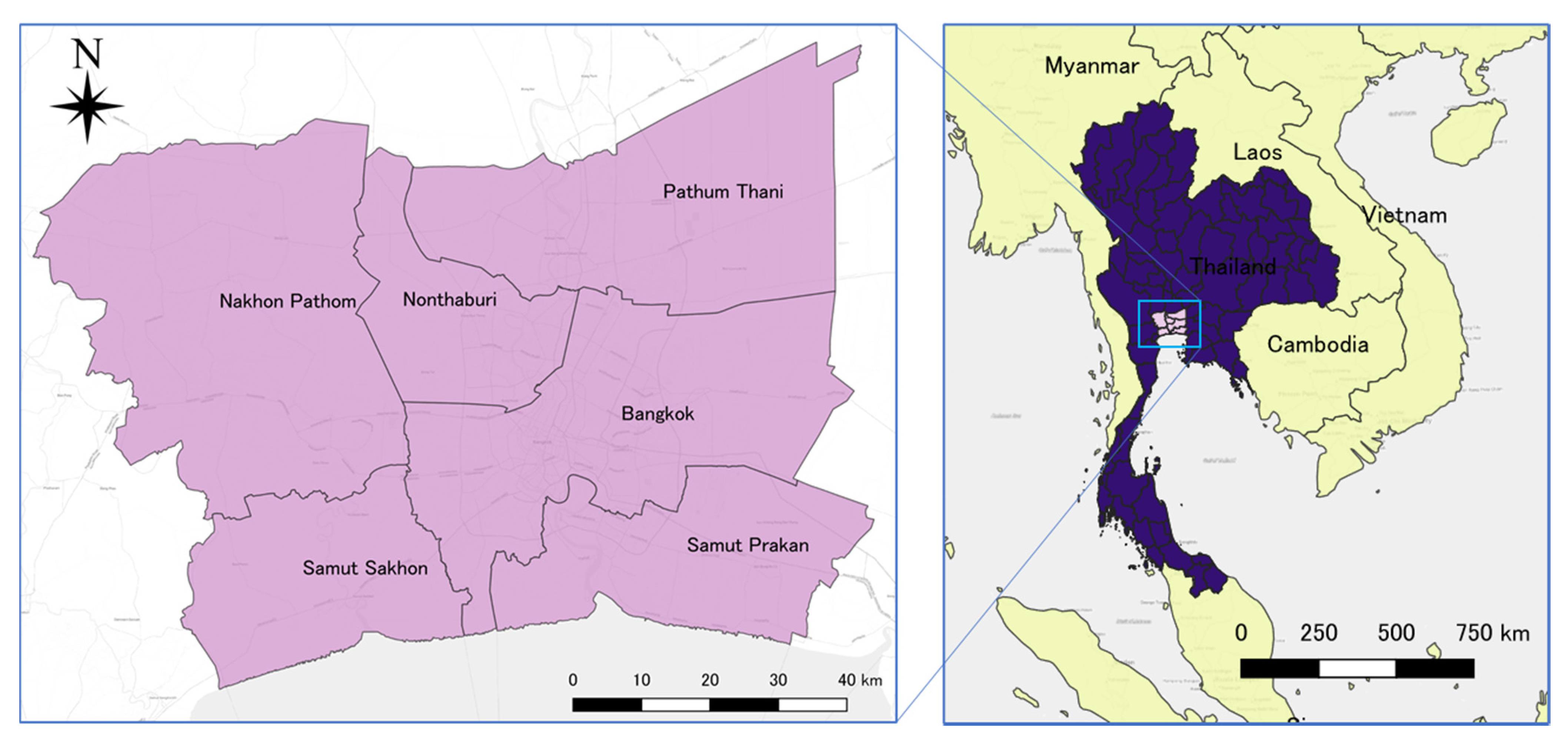
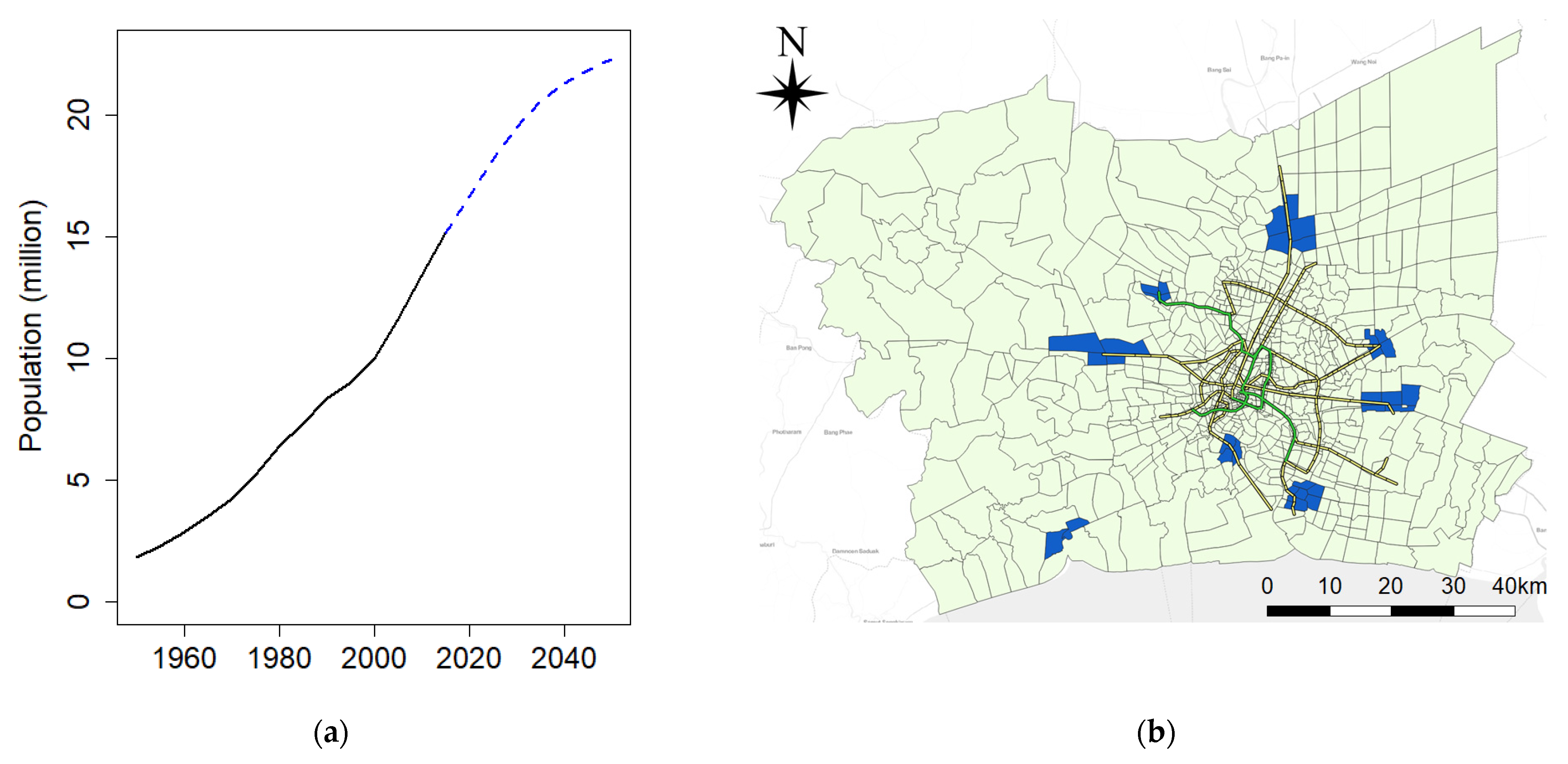
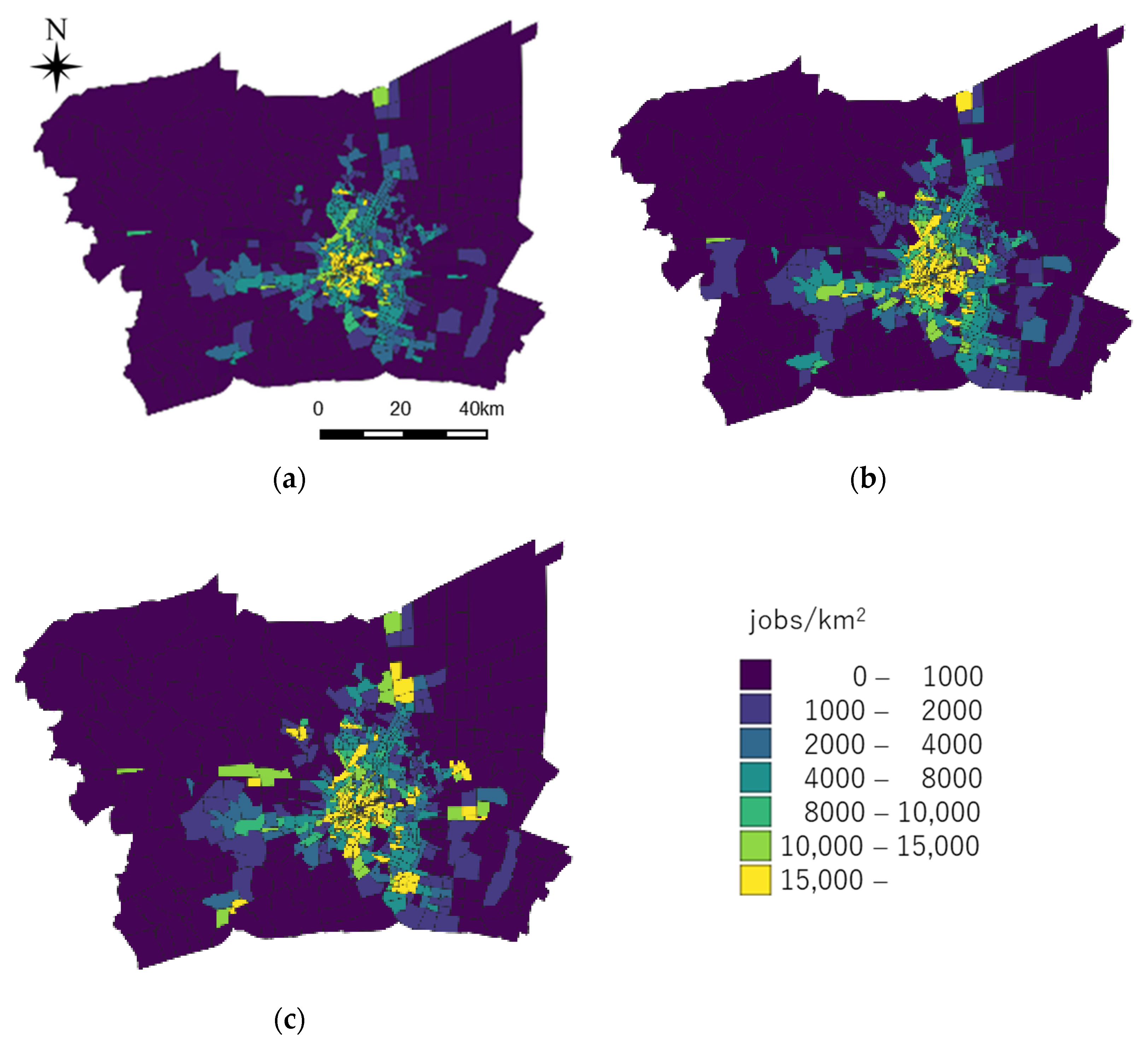

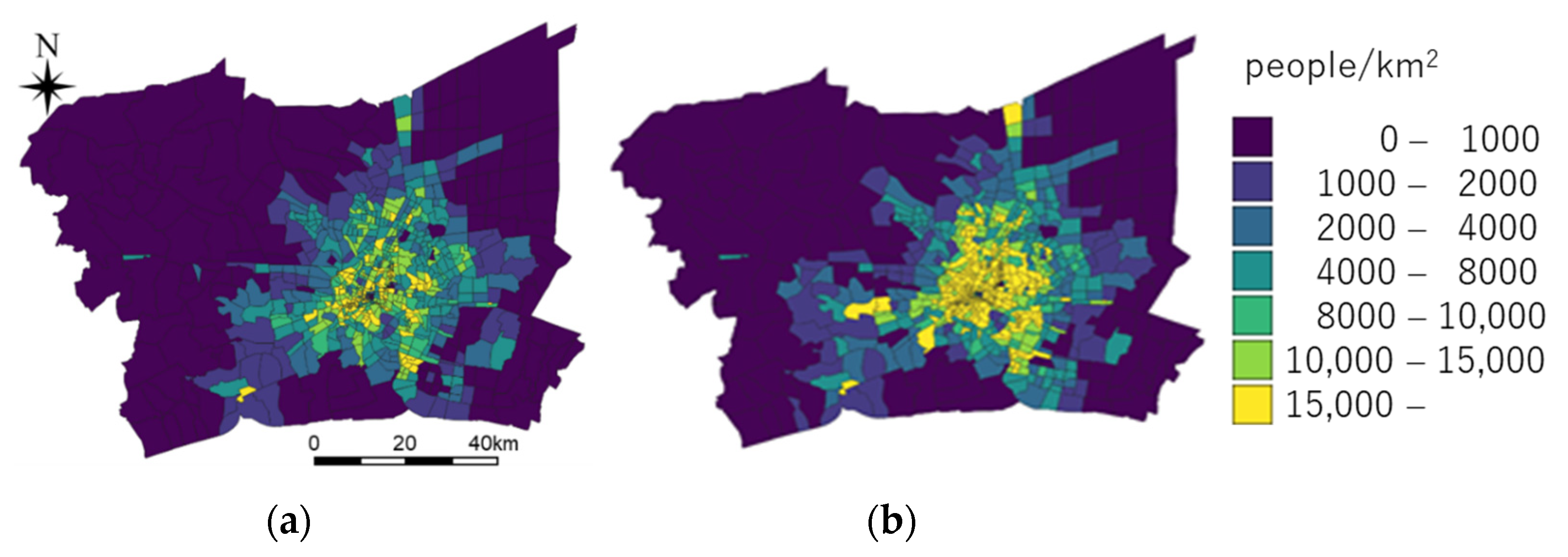


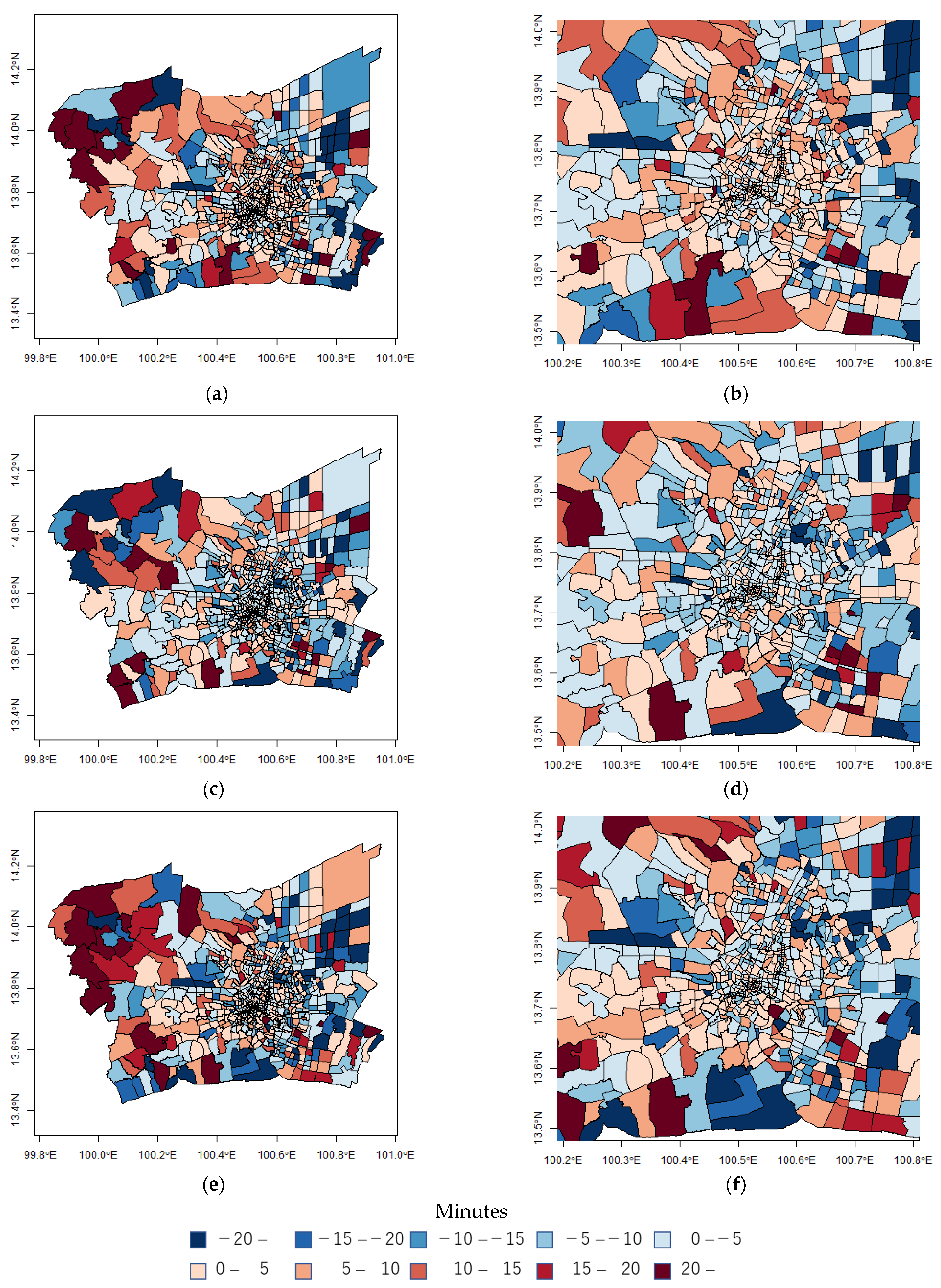
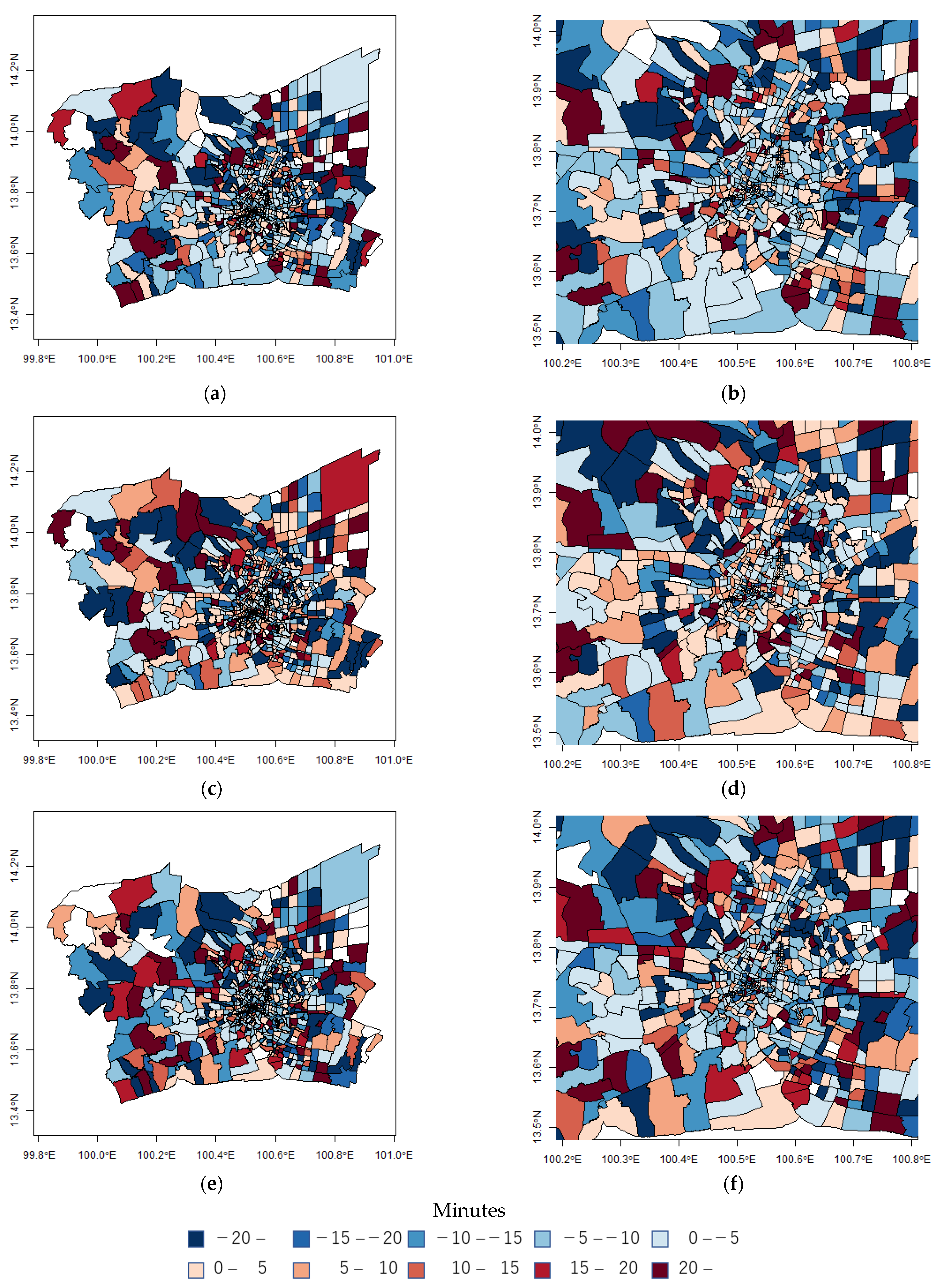
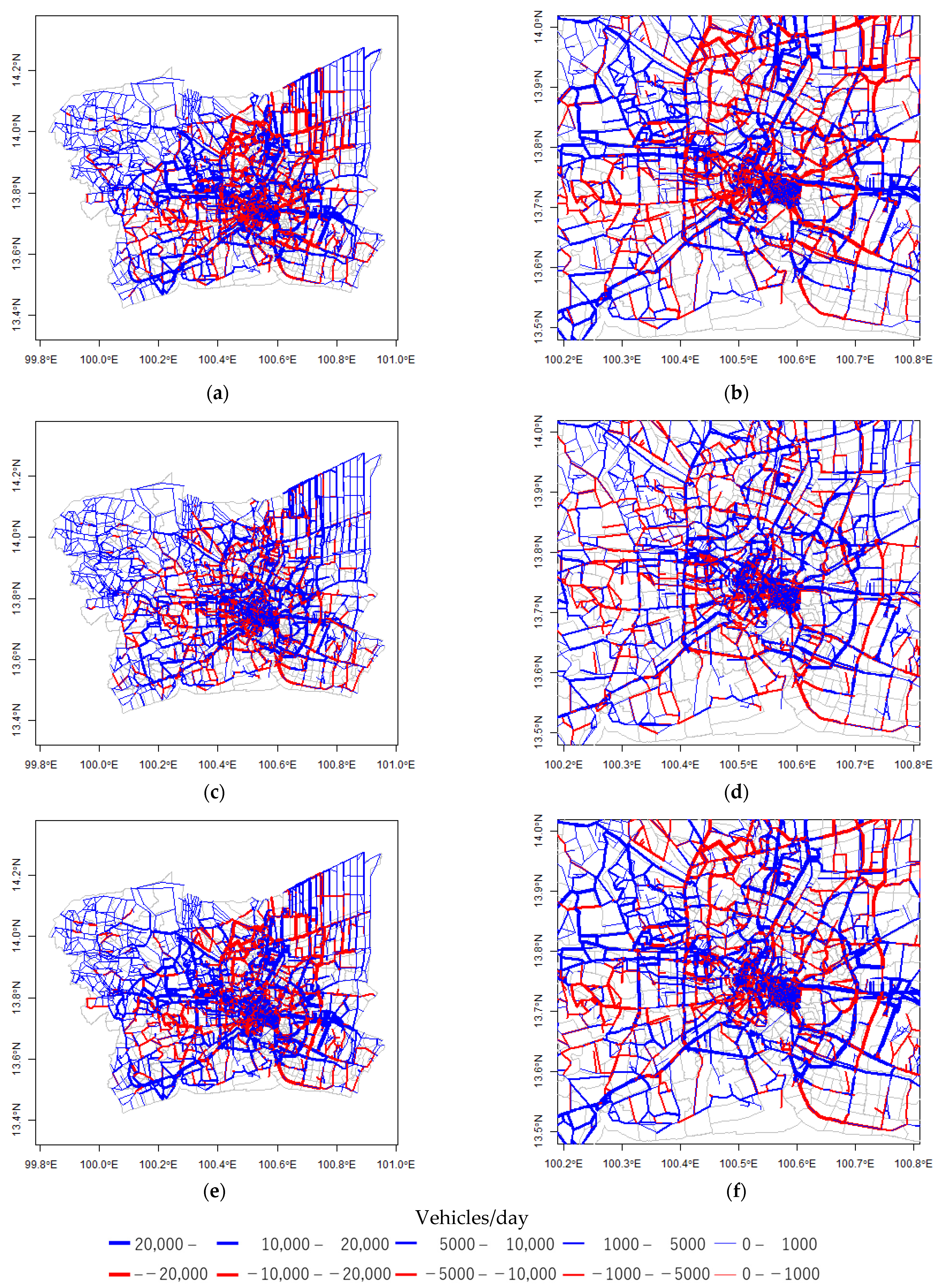
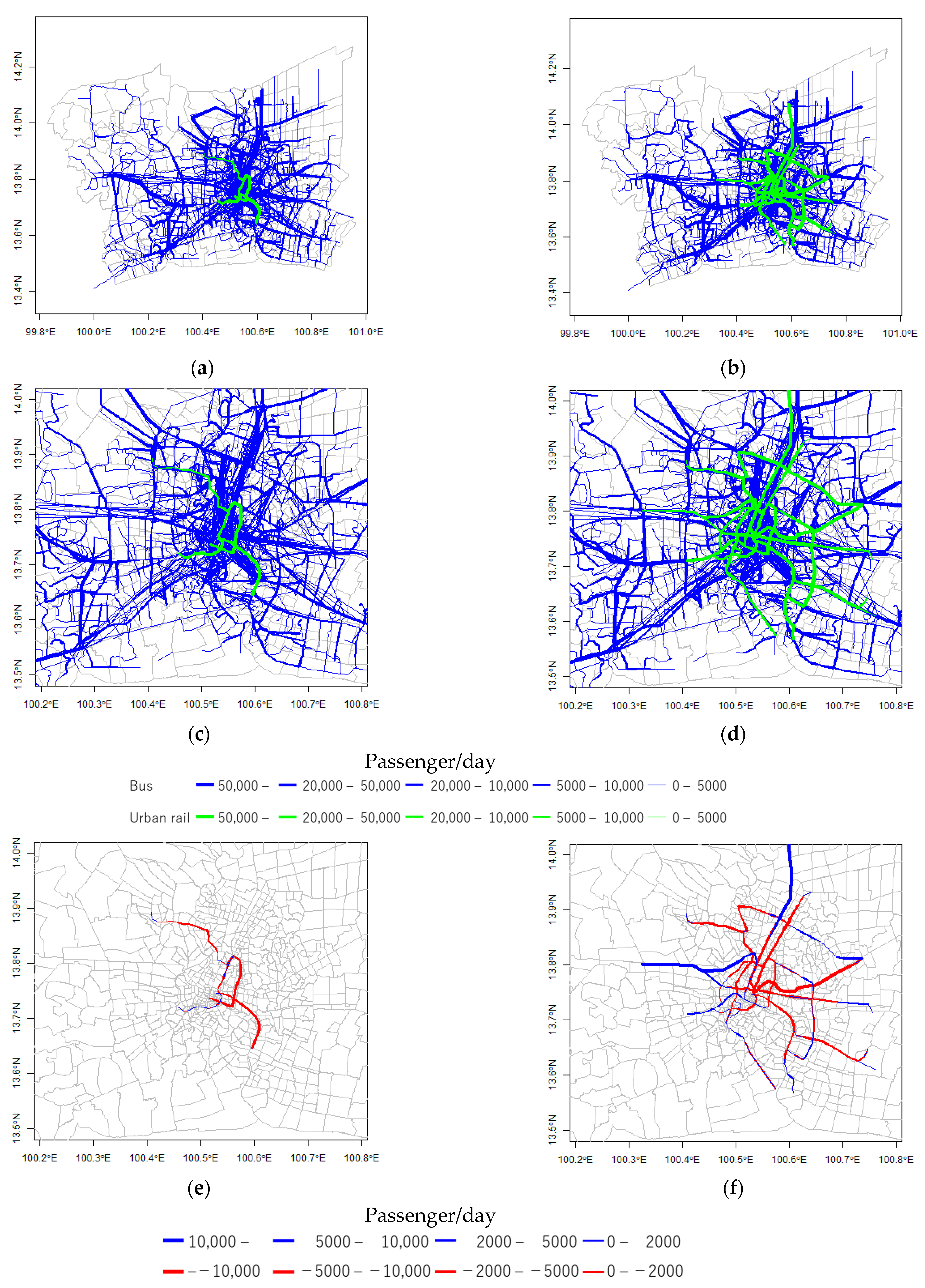
| Name | Provider | Description |
|---|---|---|
| Household Travel Survey (HTS) | The Office of Transport and Traffic Policy and planning (OTP) | Travel survey data of 18,833 households accounting for 38,054 people conducted in 2017 |
| Traffic analysis zone (TAZ) | 846 zones | |
| Public transport | GTFS data for rail lines, bus routes, and ferry (2019) | |
| Population and household | National Statistical Office | Number of population and household (2010) |
| Employment | Number of employment (2014) | |
| Population | MapFan DB Data Model | Population estimates of subdistrict by age and gender (2017) |
| Road network | Road link attributes (2018) |
| 2015 | 2050 | |||||
|---|---|---|---|---|---|---|
| Current Network | Future Network | |||||
| BAU | Sub-Center | BAU | Sub-Center | |||
| Car | Number of trips (million trips/day) | 17.5 | 25.2 | 25.3 | 25.2 | 25.3 |
| total travel length (million km/day) | 327 | 458 | 459 | 464 | 465 | |
| average travel distance (km) | 18.6 | 18.1 | 18.1 | 18.4 | 18.4 | |
| average travel time (minutes) | 46 | 109 | 104 | 114 | 110 | |
| average travel speed (km/h) | 24 | 10 | 10 | 10 | 10 | |
| Public transport | Number of trips (million trips/day) | 6.0 | 9.4 | 9.4 | 9.5 | 9.5 |
| total travel length (million km/day) | 57 | 87 | 89 | 95 | 96 | |
| average travel distance (km) | 9.4 | 9.2 | 9.5 | 10.0 | 10.1 | |
| average travel time (minutes) | 66 | 63 | 65 | 62 | 63 | |
| average travel speed (km/h) | 9 | 9 | 9 | 10 | 10 | |
Publisher’s Note: MDPI stays neutral with regard to jurisdictional claims in published maps and institutional affiliations. |
© 2021 by the authors. Licensee MDPI, Basel, Switzerland. This article is an open access article distributed under the terms and conditions of the Creative Commons Attribution (CC BY) license (https://creativecommons.org/licenses/by/4.0/).
Share and Cite
Kii, M.; Vichiensan, V.; Llorca, C.; Moreno, A.; Moeckel, R.; Hayashi, Y. Impact of Decentralization and Rail Network Extension on Future Traffic in the Bangkok Metropolitan Region. Sustainability 2021, 13, 13196. https://doi.org/10.3390/su132313196
Kii M, Vichiensan V, Llorca C, Moreno A, Moeckel R, Hayashi Y. Impact of Decentralization and Rail Network Extension on Future Traffic in the Bangkok Metropolitan Region. Sustainability. 2021; 13(23):13196. https://doi.org/10.3390/su132313196
Chicago/Turabian StyleKii, Masanobu, Varameth Vichiensan, Carlos Llorca, Ana Moreno, Rolf Moeckel, and Yoshitsugu Hayashi. 2021. "Impact of Decentralization and Rail Network Extension on Future Traffic in the Bangkok Metropolitan Region" Sustainability 13, no. 23: 13196. https://doi.org/10.3390/su132313196
APA StyleKii, M., Vichiensan, V., Llorca, C., Moreno, A., Moeckel, R., & Hayashi, Y. (2021). Impact of Decentralization and Rail Network Extension on Future Traffic in the Bangkok Metropolitan Region. Sustainability, 13(23), 13196. https://doi.org/10.3390/su132313196






